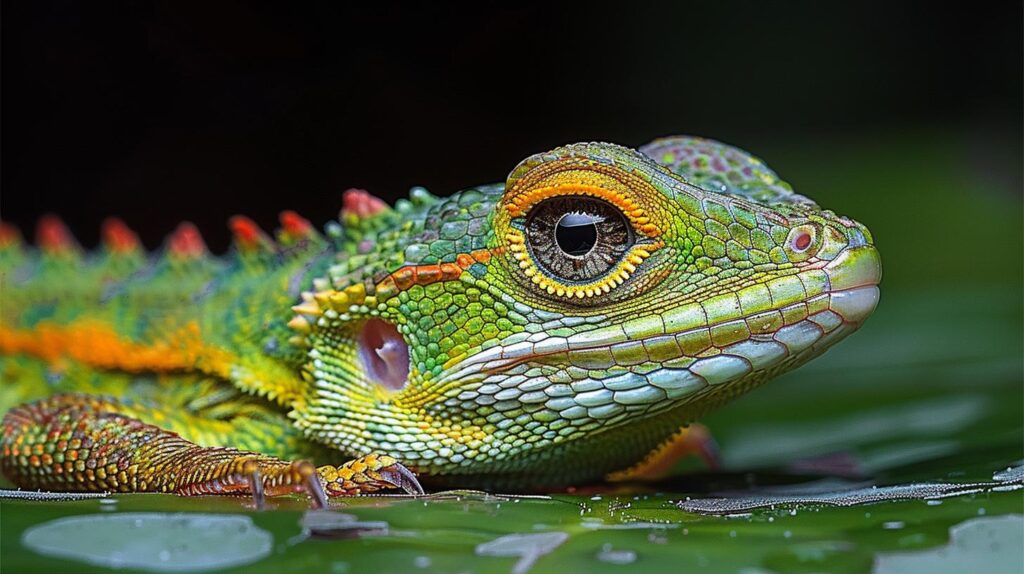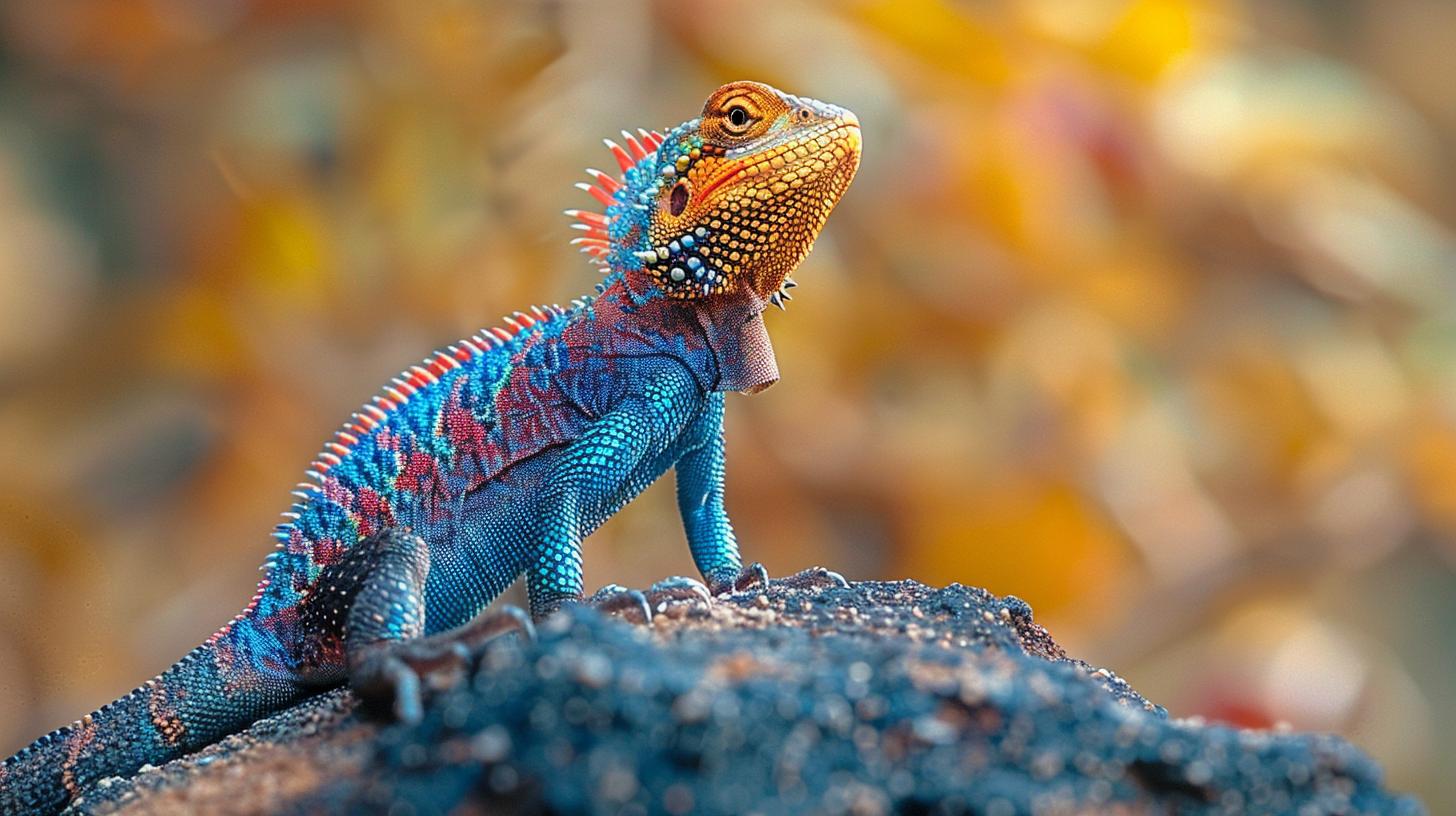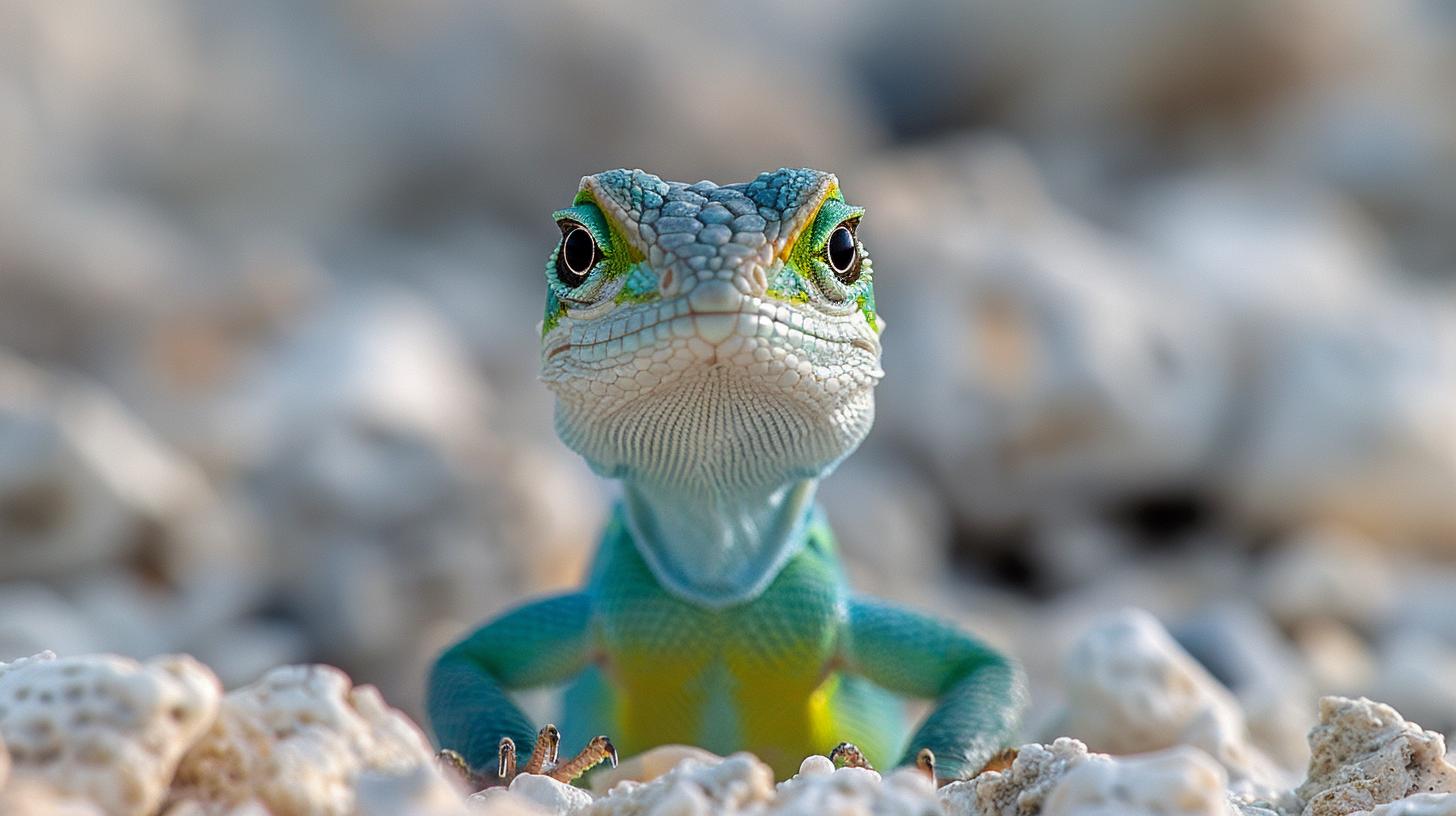7 Common Lizard Skin Infections: Care Guide

Understanding Lizard Skin Health
In the world of pet care, ensuring the health and happiness of your reptilian companion starts with a solid understanding of their needs, particularly when it comes to skin health. The beginning of a comprehensive lizard care guide must emphasize the significance of skin condition as an essential aspect of a lizard's overall well-being.
Healthy skin in lizards doesn't just contribute to their visual appeal-it's crucial for their survival, playing key roles in hydration, protection against infections, and efficient shedding. Recognizing the importance of this can help pet owners preempt many common issues that lizards face.
Delving into the realm of lizard skin health, it becomes apparent that various signs and symptoms can herald the onset of skin infections. These manifestations range from obvious changes like discoloration and lesions, to more subtle cues such as abnormal peeling or unexpected shedding patterns.
Being vigilant about these signs is vital for early detection and intervention. Understanding these indicators enables lizard owners not only to identify potential problems promptly but also fosters an environment where preventative measures are prioritized over treatments.
Among the most prevalent culprits behind these conditions are bacterial and fungal infections, each presenting unique challenges to reptile health. Bacterial infections often surface as sore spots or abscesses on the lizard's skin, necessitating immediate attention for mitigation. On the other hand, fungal infections might manifest through unusual markings or a powdery substance on the skin's surface.
Awareness and prompt action become critical here; knowing when home remedies suffice and when professional veterinary care is required can make all the difference in recovery outcomes. Thus, embracing a thorough approach towards identification and response forms an indispensable part of effective lizard care strategies.
Signs and Symptoms of Skin Infections in Lizards
Recognizing the signs and symptoms of skin infections in lizards is a critical step for any reptile owner. Early identification not only ensures prompt treatment but also prevents the infection from worsening or spreading. Among the first indicators to watch out for are changes in skin coloration or texture.
A healthy lizard's skin should be smooth and vibrant, indicative of their species-specific patterns and hues. Any dullness, discoloration, or unusual spots may signal an issue that requires closer examination.
Lesions, sores, blisters, and peeling are particularly alarming signs that often point towards a bacterial or fungal infection. These manifestations can lead to discomfort and more severe health complications if not addressed timely. It's important for lizard owners to conduct regular visual inspections of their pet's skin, looking out for these irregularities.
Additionally, abnormal shedding processes-such as incomplete sheds or patches where the old skin won't come off-can further indicate underlying skin infections. This *shedding difficulty*, often referred to as dysecdysis in the realm of herpetology, highlights potential problems within a lizard's environment or diet that could be affecting its skin health negatively.
In response to observing such symptoms, immediate action involves assessing environmental factors like habitat cleanliness, humidity levels, and overall hygiene practices related to your pet's care routine. Improving these conditions can sometimes alleviate minor symptoms; however, persistent issues necessitate professional diagnosis and treatment by a veterinarian specialized in reptilian pets. Employing a comprehensive lizard care guide can greatly assist in identifying early signs of distress as well as facilitating better preventative measures against common skin infections.
| Sign/Symptom | Possible Indication |
|---|---|
| Color change | Potential infection, environmental stress |
| Lesions/Blisters | Bacterial or fungal infection |
| Peeling/Shedding issues | Nutritional deficiencies, improper habitat conditions |
| Behavioral changes (e.g. lethargy) | Underlying health issue possibly affecting the skin indirectly |
It's clear that attentive observation paired with proactive adjustments based on sound reptile care principles are vital elements in maintaining optimum health for your lizard companion. As owners incorporate these practices into their daily routines alongside acquiring knowledge from reliable sources like a *lizard care guide*, they ensure not just prevention but also equip themselves to act swiftly should any symptoms of skin infections arise.
Bacterial Infections
Identifying Bacterial Infections
Bacterial infections in lizards can be both subtle and overt, making early detection a critical component of effective care. These infections often manifest through symptoms such as redness, swelling, pus formation, or abnormal shedding. A pivotal aspect of recognizing these signs is understanding that they are not part of a lizard's normal skin health.
This necessitates a vigilant approach from lizard owners to regularly inspect their pet's skin for any abnormalities. An integral part of a thorough lizard care guide is familiarizing oneself with the variety of bacterial infections that can affect lizards, including but not limited to Septicemia and Dermatitis. Knowledge on this can vastly improve one's response time and the effectiveness of the treatment administered.
Immediate Steps to Take
Upon suspecting a bacterial infection, immediate isolation of the affected lizard is fundamental to prevent spread to any cohabitating reptiles. After isolation, it's important to assess the environment for any potential causes of infection such as unsanitary conditions or incorrect humidity levels. Adjusting these parameters could prevent further aggravation of the infection while providing an optimal healing environment.
Prompt consultation with a veterinarian specializing in reptiles should follow these initial steps. A professional can conduct necessary tests such as bacterial cultures or skin biopsies to accurately diagnose the condition and recommend appropriate antibiotics or treatments tailored specifically for your pet.

Improving habitat cleanliness plays a crucial role in addressing and preventing bacterial infections in lizards. Ensuring that your lizard's living space is clean involves regular removal of waste, disinfecting water and food dishes daily, and maintaining proper humidity levels which vary depending on the lizard species in question.
Incorporating UVB lighting can also bolster your lizard's immune system by facilitating natural Vitamin D3 synthesis essential for healthy skin growth and repair. These preventive measures form part of an overarching strategy aimed at creating an environment where bacteria have fewer opportunities to harm your pet.
Through identifying early signs of bacterial infections in lizards and understanding immediate and long-term responses to such situations, owners can significantly enhance their pet's chances for recovery and minimize risks associated with these ailments. This segment underscores the importance not only of acute care strategies but also emphasizes preventive maintenance within lizard husbandry practices as vital components towards ensuring ongoing skin health.
Fungal Infections
Given the diverse nature of fungal organisms, these infections often present themselves in a myriad of ways on a lizard's skin - ranging from superficial blemishes to deep tissue damage. Awareness of these symptoms empowers owners to initiate prompt action, potentially saving their pet from further distress. In this context, exploring the nuances of recognizing and responding to fungal infections is not just beneficial but essential for ensuring the well-being of these reptiles.
Identifying Fungal Infections
The first step in combating fungal infections involves accurate identification of symptoms indicative of such conditions. Lizards suffering from fungal issues may exhibit patches of discolored skin, unusual shedding patterns (including incomplete sheds or retained shed), and in more severe cases, open wounds or abscesses where the infection has penetrated deeper layers. Unlike bacterial infections which often cause localized problems quickly noticed by attentive owners, fungal diseases can be insidious-progressing slowly while stealthily undermining a lizard's health.
Treatment Modalities
Once suspicion falls on a fungal origin for a lizard's ailment-often after ruling out bacterial or parasitic causes-the next course of action is determining an effective treatment regimen. Approaching treatment typically consists of both topical ointments designed to combat surface-level fungi and systemic medications for more pervasive infections.
Many vets will recommend a combination therapy that includes improving habitat conditions (such as reducing humidity) alongside pharmaceutical interventions. It's crucial that treatments are adopted based on professional veterinary advice rather than relying solely on observation; misdiagnosis can exacerbate underlying issues or induce unnecessary stress upon the animal.
Prevention Is Key
Incorporating preventive measures within your lizard care guide can significantly reduce the incidence of fungal attacks. Maintaining optimal environmental conditions within terrariums acts as the first line of defense against many opportunistic fungi seeking to exploit compromised hosts. Regular cleaning schedules, proper ventilation systems, controlled humidity levels, and thorough monitoring for any signs of distress are aspects covered in diligent care routines that promise healthier lives free from such afflictions.
By focusing attention on understanding fungal concerns meticulously and adopting robust response strategies when needed, owners play an indispensable role in safeguarding their lizards against these pernicious pathogens-highlighting once again the importance placed on timely intervention and earnest caretaking practices in preserving reptilian wellness.
Parasitic Infestations
In the complex world of lizard care, parasitic infestations stand out as one of the more challenging issues owners may face. Mites, in particular, are notorious for targeting lizards, burrowing into their skin and causing a variety of problems. These tiny parasites can be detrimental to a lizard's health if not addressed promptly.
Recognizing the signs of mite infestation is crucial for any responsible owner. Symptoms include noticeable discomfort, excessive scratching, visible small black or red dots (mites) on the skin or habitat surfaces, and in severe cases, anemia due to blood loss.
Lizard care guide strategies emphasize the importance of early detection and immediate action. The initial step in combating mites involves thoroughly cleaning the lizard's habitat; this includes disposing of substrate, sanitizing the enclosure with reptile-safe products, and heating it if possible to eliminate any remaining pests. It's also advisable to quarantine the affected lizard from any other reptilian pets to prevent the spread of mites.
- Quarantine procedures: Isolate the infected lizard to curb the spread.
- Habitat sanitation: Replace substrates and clean all surfaces with reptile-friendly disinfectants.
- Veterinary consultation: Seek professional advice for appropriate medication.
After addressing environmental concerns, focusing on direct treatment for your pet is next. A variety of anti-parasite medications are available but must be used with caution; always consult a veterinarian before applying any treatment to avoid harming your lizard inadvertently. Solutions such as *ivermectin* can be effective when used correctly under veterinary supervision.
Continuing vigilance even after eradication offers your best defense against a recurrence. Regular checks for early signs are imperative as part of ongoing *lizard care guide* practices. This proactive approach extends beyond just handling parasitic threats; it encompasses maintaining optimal conditions within your pet's environment - proper humidity levels, temperatures suitable for your specific lizard species, and stress reduction techniques significantly contribute to a strong defense system against various infections.

By incorporating these measures-all aimed at understanding *mites* and their risks while emphasizing preventive strategies-lizard owners can better safeguard their pets' skin health against parasitic invasions. As we delve deeper into components essential for robust reptilian skin care in subsequent sections, remember that amidst these challenges lies the opportunity for owners to deepen their bond with their pets through diligent care and attention.
Nutritional Deficiencies Affecting Skin Health
Addressing nutritional deficiencies is crucial in maintaining the healthy skin of lizards. An imbalanced diet not only affects their overall health but can also lead to serious skin issues, such as flaky or dull skin, lackluster coloration, and delayed shedding process. These symptoms are often a clear indicator that your lizard might be suffering from a lack of essential vitamins and minerals, underscoring the importance of a well-rounded diet in preventive health care.
Incorporating a balanced mix of proteins, fats, vitamins, and minerals into your lizard's diet cannot be overemphasized. For insectivorous species, ensuring that feeder insects are gut-loaded with nutritious food before being offered as a meal adds an extra layer of nutrients beneficial for your lizard's skin health.
Similarly, herbivorous lizards thrive on a diverse selection of greens rich in vitamins A and E, which are known to support healthy skin. Calcium and vitamin D3 supplements are also integral in preventing metabolic bone disease, another condition that can indirectly affect skin health due to its impact on overall physiological well-being.
A practical approach to preventing nutritional deficiencies involves implementing the following strategies:
- Offer a variety: Ensure your lizard's diet includes all necessary components according to their species-specific needs.
- Supplement wisely: Use calcium and vitamin supplements appropriately to avoid under or overdosing.
- Monitor health: Keep an eye on your lizard's skin condition and overall health, adjusting their diet as needed.
By taking these steps diligently within your *lizard care guide*, you will significantly reduce the likelihood of nutrition-related skin issues. It's important for pet owners to understand that each species may have unique dietary requirements; therefore, researching or consulting with a veterinarian for species-appropriate diets is recommended.
Upcoming sections will delve deeper into establishing rigorous habitat maintenance routines and hygiene practices as part of comprehensive preventative measures against common skin infections in lizards. This holistic approach not only ensures optimum skin health but contributes greatly to the overall wellbeing of these fascinating creatures.
Lizard Care Guide
As we reach the close of our exploration on common lizard skin infections and preventive measures detailed in our comprehensive lizard care guide, it becomes abundantly clear how vital a role attentive, informed care plays in fostering the health and happiness of our reptilian pets.
The journey through understanding lizard skin health to identifying signs and symptoms, addressing bacterial and fungal issues, grappling with parasitic invasions, and acknowledging the importance of nutrition illuminates just how interconnected these factors are in ensuring the robust well-being of lizards.
Adopting the preventive strategies outlined, from maintaining optimal habitat conditions to ensuring dietary balance and conducting regular health checks, can significantly mitigate the risk of these common yet concerning infections. It's not merely about reacting to problems as they arise but about creating a stable, supportive environment that wards off potential threats to your lizard's health before they become manifest.
This proactive approach underscores our message; an ounce of prevention is truly worth a pound of cure when it comes to safeguarding the delicate skin health of these fascinating creatures.
We invite you to continue this journey towards exceptional reptilian care by delving further into our site. With an array of articles ranging from detailed care sheets for various species to insights on behavioral understanding and habitat optimization, there's always more to learn and ways to enhance your pet lizard's life.
Let our expertise be your guide in nurturing a thriving relationship with your scaly companion. Click through for deeper insights today-your commitment makes all the difference in their world.
Frequently Asked Questions
Is It Hard to Take Care of a Lizard?
Taking care of a lizard involves understanding its specific needs related to diet, habitat, and health. While some lizards require minimal daily care, others may need specialized environments or diets to thrive. It's not necessarily hard; it just requires doing some homework and regular attention to ensure your lizard is healthy and happy.
How Do You Keep Lizards Alive?
Keeping lizards alive and well entails providing a suitable environment that mimics their natural habitat as closely as possible. This includes the right temperature gradients, appropriate lighting (such as UVB for many species), a proper diet consisting of either insects, vegetables, or both depending on the species, and regular cleaning of their enclosure to prevent disease.
What Do You Need to Own a Lizard?
To own a lizard, you will need an enclosure or terrarium that meets the size requirements for your specific type of lizard.
Other necessities include heating and lighting equipment to maintain the correct temperature and light cycles, substrate (bedding) for the bottom of the enclosure, food suitable for your lizard's dietary needs, water dishes or drip systems for hydration, and enrichment items like hiding places or climbing structures to stimulate natural behavior.
Can I Keep a Lizard I Found Outside?
While finding a lizard outside might spark the desire to keep it as a pet, it's often discouraged due to several reasons. Wild lizards can carry parasites or diseases that might be harmful if brought indoors.
Additionally, capturing wild lizards can disrupt local ecosystems and biodiversity. Instead, consider adopting a lizard from a reputable breeder or rescue organization that can provide information on how to care for them properly.
Leave a Reply
You must be logged in to post a comment.